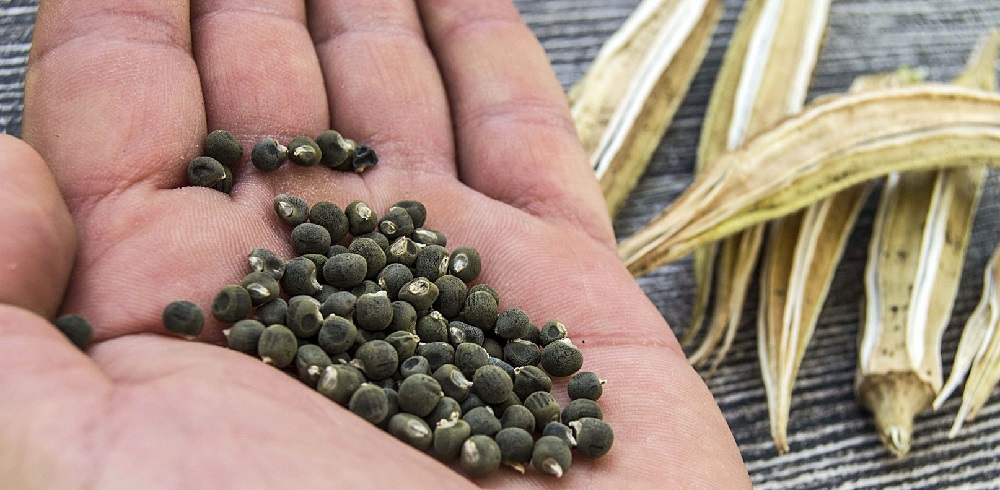Okra Propagation

This post is also available in:
This post is also available in:
![]() Français (French)
Français (French) ![]() Deutsch (German)
Deutsch (German) ![]() Ελληνικά (Greek)
Ελληνικά (Greek)
Propagation refers to the process of reproducing plants from seeds, cuttings, or other plant parts. In the case of okra, propagation can be done through seeds or cuttings. Here are some methods for propagating okra:
1. Seed propagation
The seed should be planted directly in the ground when the weather is warm and soil has adequate moisture to support germination. Okra seeds can be sown directly in the garden bed after the last frost or started indoors in pots 6-8 weeks before the last frost. Sow the seeds 1 inch deep and 6-8 inches apart (15-20cm). Once the seedlings have grown a few inches tall and have several leaves, they can be thinned to 10-20 inch (30-50cm) apart.
2. Stem-cutting propagation
Take 6 to 8 inch (15-20cm) long cuttings from the tips of okra branches. Remove the lower leaves, leaving only a few at the top. Dip the cuttings in rooting hormone, and plant them in pots filled with moist potting soil. Place the pots in a warm, bright location, and keep the soil moist. In about 2-4 weeks, the cuttings should develop roots and can be transplanted into the garden.
3. Division
Okra can also be propagated by dividing mature plants. Dig up a mature okra plant and separate the roots into two or more sections. Replant each section in a prepared bed or pot.
It’s important to note that okra prefers warm soil and full sun and requires regular watering to moisten the soil.
Regardless of the method used, successful plant propagation requires attention to detail, appropriate growing conditions, and proper care and maintenance of the new plants
Read more:
- Hibiscus esculentus – Okra seeds
- Okra Pests, Disease and Weed management
- Okra: Harvest, Yield, Storage, and Post-harvest handling
- Okra Water Requirements and Irrigation Systems
- Soil Preparation and Planting in Okra Farming
- Okra Propagation
- Okra Fertilization Requirements
- Okra: History, Nutritional Value, and Plant Information
References:
Alsos, G.A.; Ljunggren, E.; Pettersen, L.T. Farm-based entrepreneurs: What triggers the start-up of new business activities? J. Small Bus. Enterp. Dev. 2003, 10, 435–443.
Barth, F. Economic Spheres in Darfur. In Themes in Economic Anthropology; Firth, R., Ed.; Routledge: London, UK, 1967. 75. Singer, A.E. Reflections on Eco-Preneurship. 2012.
Cavalli, D.; Cabassi, G.; Borrelli, L.; Geromel, G.; Bechini, L.; Degano, L.; Gallina, M. Pietro Nitrogen fertilizer replacement value of undigested liquid cattle manure and digestates. Eur. J. Agron. 2016, 73, 34–41.
Dijkxhoorn, Y., De, B., Piters, S., Brouwer, I., Hengsdijk, H. & Tichar, T. 2021. Enhancing fruit and vegetable consumption in low- and middle income countries through a food systems approach. The Hague, The Netherlands, Wageningen Economic Research.
FAO & WHO. 2019. Food control system assessment tool: Dimension A – Inputs and resources. Food safety and quality series No. 7/2. Rome, FAO.
Hoffmann, V. & Jones, K. 2021. Improving food safety on the farm: Experimental evidence from Kenya on incentives and subsidies for technology adoption. World Development, 143:
Jaffee, S., Henson, S., Unnevehr, L., Grace, D. & Cassou, E. 2019. The safe food imperative: accelerating progress in low- and middle-income countries. Agriculture and Food Series. Washington, DC, World Bank.
Kim, D.G.; Saggar, S.; Roudier, P. The effect of nitrification inhibitors on soil ammonia emissions in nitrogen managed soils: A meta-analysis. Nutr. Cycl. Agroecosyst. 2012, 93, 51–64.
Mencaroni, M.; Dal Ferro, N.; Furlanetto, J.; Longo, M.; Lazzaro, B.; Sartori, L.; Grant, B.B.; Smith, W.N.; Morari, F. Identifying N fertilizer management strategies to reduce ammonia volatilization: Towards a site-specific approach. J. Environ. Manag. 2021, 277, 111445.
Moumenihelali, H.; Sadighi, H.; Chizari, M.; Abbasi, E. Pluriactivity: An Entrepreneurial Strategy for Smallholder Farmers. J. Entrep. Agric. 2020, 6, 112–124.
Nitrogen Use Efficiency (NUE)—An Indicator for the Utilization of Nitrogen in Agriculture and Food Systems; EU Nitrogen Expert Panel: Wageningen, The Netherlands, 2015.
Sá, E.; Casais, B.; Silva, J. Local development through rural entrepreneurship, from the Triple Helix perspective. Int. J. Entrep. Behav. Res. 2019, 25, 698–716.
Sequeira, R.R. Factors Affecting Rural Entrepreneurship. Int. J. Res. Eng. Sci. Manag. 2020, 3, 239–240.
- https://extension.uga.edu/publications/detail.html?number=C627
- https://extension.uga.edu/publications/detail.html?number=C627
- https://www.uky.edu/ccd/sites/www.uky.edu.ccd/files/okra.pdf
- https://extension.okstate.edu/fact-sheets/okra-production.html








































































